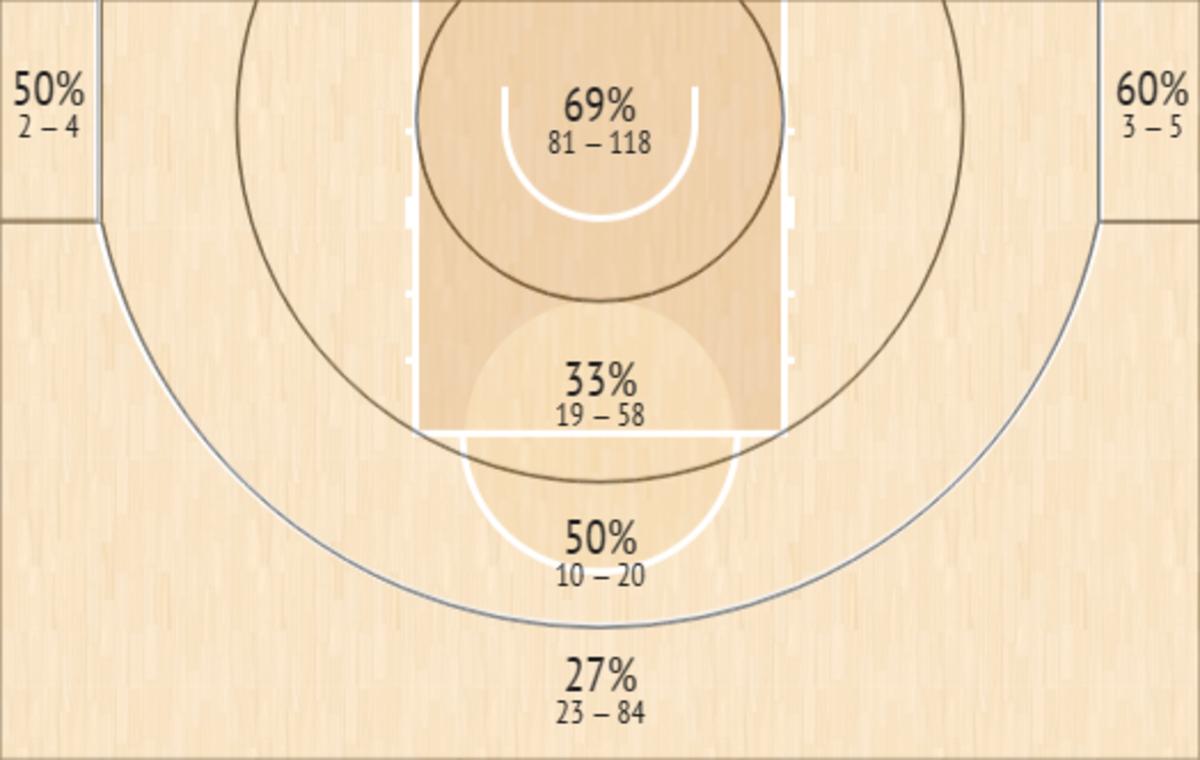The Map of Victor Wembanyama: Back to the Basket

The Map of Victor Wembanyama is a series where I try to identify the smaller aspects that comprise each skill of the projected number one pick in the 2023 NBA Draft. I look at how Victor can utilize each micro-skill to be valuable at the NBA level and which micro-flaws opposing teams could utilize to gain an advantage whenever he’s on the floor. Catch up with previous regions of The Map here:
Part Two: Catch-and-Finish Scoring
This region of The Map will pick up right where the previous installment ended: by looking at Wembanyama’s updated shot chart.

After focusing on his impressive efficiency in his shots around the rim in our previous episode, this week we move a few feet away from, as we’ll be focusing on his shot attempts between 8 and 16 ft from the basket, a range in which Wembanyama is forced to self-create.
This is The Map of Victor Wembanyama, Part Three: Back to the Basket
1. Struggling to Establish Position
One of the reasons why Wembanyama takes 20% of his shots from a range in which he only shoots 33% is because of his physical inability to consistently establish position closer to the basket. These limitations to establish and hold his position turns what would be easy catch-and-finish opportunities into harder self-created shots from the mid-range.
This happens mainly due to three physical factors. The lack of strength in his lower body and his high center of gravity make it hard for him to both back opponents down to the paint with the ball in his hands and to simply keep his position after catching the ball inside. His lack of upper body strength also comes into play, even when Wembanyama attempts to create space by being physical against defenders in the post, they are able to stand their ground, hold him off the paint and force him into tough shots.
In order to neutralize some of these limitations, the Metropolitans’ coaching staff does a good job of utilizing pindown actions in the low post which allow Victor to get open and catch the ball with both feet planted in the restricted area, but even in those opportunities, Wembanyama tends to rush into his shot, likely knowing that he’s not going to be able to hold position for long.
2. Touch Against Contact
Due to his limitations to both establish deep position and to back opponents down to the post, Wembanyama relies almost exclusively on tough, off-balance shots, which he converts at a pretty good rate thanks to his combination of touch, extension and hangtime.
When catching the ball in a crowd, Wembanyama is able to take a dribble to find the open space before rising up for floaters, runners, long range layups and other off-balance shots, which require an advanced level of touch and hangtime.
When he’s forced to turn around, face up and attack a defense from short to mid-distances, he shows not only the touch, polish and coordination to put the ball on the floor, but also the tools such as his length, flexibility and sheer size, which allow him to get to the rim in one stride and finish with extension at the rim, making him extremely difficult to stop for opponents.
While Wembanyama is right handed, he has shown to be a capable finisher with his left as well, as he’s now shooting 44% on 18 shot attempts with his left hand through the 2022-23 season according to InStat. His evolution throughout the season has been impressive, after attempting just 0.4 shots per game with his left hand during the first 8 contest of the season, he has nearly quadrupled his shot attempts, now going for an average of 1.5 left handed attempts over his the last ten games.
Wembanyama’s willingness to play through contact makes him get to the line at a solid rate, as he’s shooting over 6 free throws per game during the season. Personally, I feel like Wembanyama gets a pretty friendly whistle for international basketball standards, with most of the 50/50 calls going his way.
Will he get the same amount of foul calls in the NBA? The offensive player always gets the benefit of the doubt in today’s NBA, and while it can be hard for rookies to get the respect of referees during their first few years in the league, Wembanyama’s style of play and his susceptibility to contact should tip the scale in his favor, making referees call plays in his favor with a certain level of consistency.
3. Footwork and Handles
Wembanyama does not simply rely on just his touch against contact to self-create in the mid-range, as he shows impressive coordination and polish to put the ball on the floor and find the open space.
Everything starts with his ball security. I watched every single one of his 41 turnovers this season and just six of them came from post-ups: two of them were via double teams and three of them were unforced errors (i.e. dribbling the ball off of his foot). Just one of them had him lose control of the ball in a one-on-one situation.
Wembanyama’s massive hands have an impact on his ball security as they allow him to catch and secure the ball against defenders. When he rises up for a shot attempt, Wembanyama is also able to cup and hold the basketball with one hand in the air, without having to worry about bobbling it and turning it over against contact.
Wembanyama combines his massive measurements and his security as a ball-handler with his coordination and mobility which allows him to put the ball on the floor, change directions quickly and find the open space after spin moves, without ever risking losing the ball. This ability to spin leaves opponents little time to recover if they overplay one side when defending him on post ups.
Despite his lack of strength, Wembanyama is able to spin off of his pivot foot and find the open space after opponents commit to one side of the ball. His long legs allow him to cover massive distances with just one step, without traveling or needing to put the ball on the floor.
His massive measurements, touch and ability to finish through contact give him a natural advantage in these situations and affect his understanding of spaces and how to cover distances. Catch the ball right outside the restricted area? No problem, that’s at arms length for him.
4. (Not) Going Left
There was a common trend in the clips in the previous section that some might have noticed, all the plays where Wembanyama caught the ball with his back to the basket ended up with him turning to his right shoulder. So, what happens when he turns the other way?
With his ability to handle the ball, spin and change directions in post-ups it’s concerning how opponents can simply overplay his right side because Wembanyama will either take a long time to turn over his left shoulder or just won’t attack that side at all. Once he commits to go to his right, he won’t turn back left, even if that means settling for a more difficult shot attempt or even walking right into double teams.
When he does go to his left, whether it is for layups or jumpers, finishes look uncoordinated and downright iffy, lacking the level of touch and coordination he shows in some of the difficult, off-balance finishes at the rim that I mentioned in previous sections.
What makes it even more inexplicable is that Wembanyama does have the coordination and footwork to make spin moves and the touch to convert difficult shots off-balance. The touch with his left hand is also there. These are all points I have made through the past few paragraphs. So why would he have so much difficulty with going left in order to attempt something that he makes look so simple whenever he goes to his right?
Once he gets to the NBA, the focus should be to develop his instinct to go left with enough time and repetition both in practice and in semi-competitive settings. I’m sure that this is something that can be trained into someone who has so much natural talent and polish. Until then, defenders at the NBA level will be able to focus on his right side, knowing that deciding to attack to his left and actually finishing those situations is something that Wembanyama struggles with.
Final Thoughts
This area of the map shows us that Wembanyama is not perfect as a prospect and certainly has areas for improvement, as every prospect in the history of basketball had. As of this point, Wembanyama is better as a play finisher than as a self-creator in the paint, as he is limited by his lack of strength which makes him unable to establish deep position with consistency and by his limitations to turn to his left shoulder.
While these are all aspects in which he certainly could improve, it could be speculated that his limitations as a self-creator from the post have forced Wembanyama to develop other areas of his offensive repertoire.
Basketball is similar to chess, in a way you win the game by forcing your opponent to pick their poison and as we’re going to see in the next few regions of The Map, Wembanyama has developed his ball-handling and shooting to a point where it might not matter that much if he can’t back down opponents to the paint, because he can simply shoot over them or take them off the dribble.
Want to join the discussion? Like Draft Digest on Facebook and follow us on Twitter to stay up to date on all the latest NBA Draft news. You can also meet the team behind the coverage.
